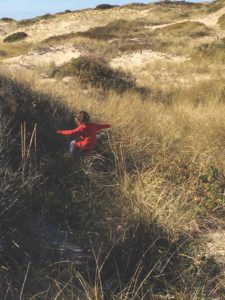
Atlantic to the left, Race Point behind us, we hauled our buckets and baskets and red and yellow plastic beach pails over dune-tops, into hollows, and along the overgrown sand road to the cranberry bog.
It was a bright Sunday in early November. Joshua, my fisherman-husband, had glanced at the neighbor’s trees that morning and guessed that the winds would be favorable for a dune outing, a homegrown meteorology based on the rate of flutter in the uppermost leaves. So we packed a lunch, shoved the toolbox into the back of the Jeep in case the family dune shack needed work, and threw in some extra sweaters and woolly hats. Not that we mistrusted his weather instincts.
I remember once, years ago, before we were married, driving out to the shack on a warm May night, the air so still not a blade of grass twitched in the beams cast by our running lights. We arrived just before the tide changed, and when it did, Josh had promised, the wind would begin. I was skeptical — the stillness seemed absolute. But just as we reached the door of the shack with our load of provisions, a new sound joined the swish-swishing of our feet in the sand: a hiss in the grass that grew and grew until the air picked itself up and hurled itself bodily at us. The wind blew all night long. Forecast correct.
But now there are children — small children, who look even smaller to us when we drop them into the sea of dunes. For the younger of the two, getting out of her daddy’s boot print in the sand is an uphill effort. Her older sister, a budding explorer, still needs a few more inches in height to clear the thorny thickets of rosa rugosa that steal her mittens and scarves. Watchfulness over these two is required, and layers to fortify them against fickle ocean breezes.
For the moment, we were enjoying the sun, the strange, beautiful colors in the scrub — ambers, bronzes, browns verging on plum — and the calm. In the bog, all was quiet except for the squeaky chatter of a few tree swallows overhead and the “plunk” of berries in our pails. There were long intervals between “plunks” today, due partly to the thinness of the crop and partly to distraction. Instead of fat berries bunched in dense patches, small ones glowed singly from scattered parts of the bog, forcing us to cover more ground between picks and giving the children opportunities to wander off on their own tangents. Maisie, three, became lost in contemplation of a dried stalk of goldenrod with cream-colored fluff where the flowers had been. Zoe, seven, trapped a leafhopper with brown papery wings and let it circle her hand before launching it back into the bog.
Being small, it turns out, has its advantages. Eyes close to the ground catch the details. There were tracks in the sand to ponder, and pin-headed lichen to look for along the dune floor. A spider to study in a low-lying web. Chalky blue bayberries to practice counting with. By the time Maisie strayed into a soggy part of the bog and soaked her shoes, and the expedition came to an end, we’d had our fill of adventure, even if our buckets were light.
Back we went, along the faint path through the hills — Atlantic to our right, Race Point ahead — talking about all the things we were going to bake with our cranberries. Josh, passing some animal tracks in the sand, told the girls a story about how their step-grandfather once spent three whole days stalking a box turtle through the Provincelands. As we walked, a breeze picked up, enough to keep Maisie pushing the hair back from her eyes. We shuttered the shack, loaded up the Jeep and arrived at our house — three towns but really a world away — just before dark.
The wind held off until two nights later, when it blew the last leaves off the neighbor’s trees. We were inside, eating bowls of cranberry crisp.



